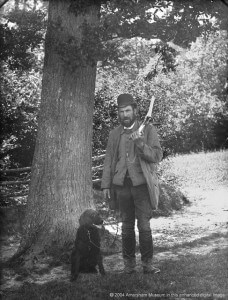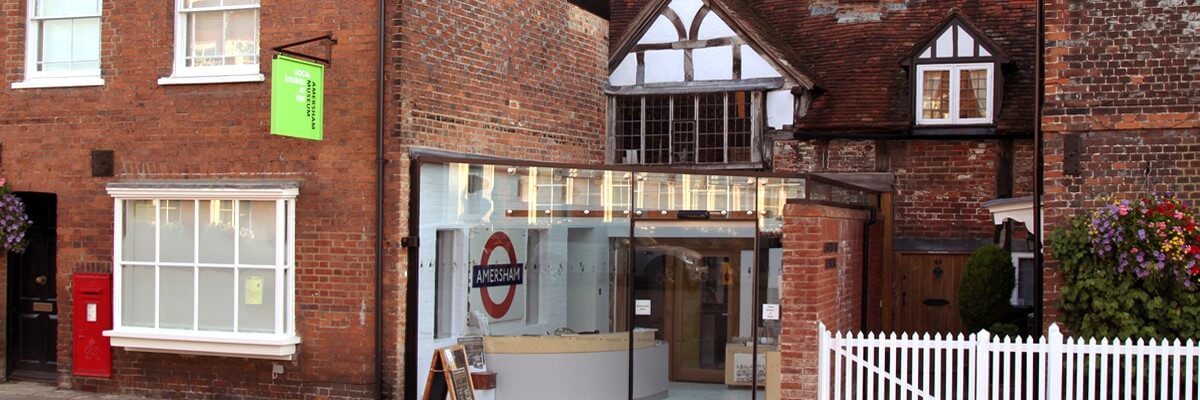400This article was written by Michael Brooks for the Amersham Society/Amersham Museum newsletter and is reproduced here with permission.
A recent visitor to the town enquired how many people died here from the plague. For many reasons this is an impossible question to answer. The plague, also known as the Black Death, which swept across Europe in waves from the early 14th century, was caused by a bacterium known as yersinia or pastuerella pestis which lives in the digestive tract of fleas, particularly rat fleas. Flea bites of humans caused a bubonic type of the plague which was highly lethal, killing 50 to 60% of its victims. A less common pneumonic type of the disease spread from person to person, especially in cold weather, was even more virulent. The sneezing caused by the pneumonic type is said to be the origin of the nursery rhyme ‘Ring-a-ring of roses, a pocket full of posies. Atishoo, atishoo, we all fall down’ – the bitter experience of more than half those infected. A further rarer septicaemic type, born by fleas and body lice was universally fatal within 24 hours. As well as rat vectors, fleas could be carried in rags, bulky merchandise and even grain. Fleas carrying the plague bacillus could exist for up to 50 days without food but took the first opportunity to bite any animal with which it came in contact.
Permanent reservoirs of the disease existed in rodent populations in Asia and Africa and to a minor extent they still do, even in the USA. The plague is known to have existed in Athens in 5BC. In AD 541 Justinian recorded a pandemic which spread throughout the Byzantine Empire and most of the known world – a quarter of the European population south of the Alps are said to have perished and recurrent epidemics are said to have kept the European population numbers static. From the 8th to the mid-14th century Europe was remarkably free from the plague. However, in 1348 an outbreak of what became known as the Black Death reached France and then England. It is believed that it originated in the Gobi desert whence it spread across India and Central Asia, the Middle East and the Mediterranean. Outbreaks of the Black Death were to occur sporadically throughout the Middle Ages, limiting the rise in population numbers and causing much misery and many problems, especially in agriculture which was labour intensive. During the 17th century the plague became endemic throughout the country, but by 1670, as suddenly as it had come, the disease disappeared from Britain.
Plague mortality in the 17th century in Buckinghamshire is well documented in an article in Records of Buckinghamshire, Volume XX (1977). The worst plague outbreaks were in Wing and Aylesbury in 1603/4 and in High Wycombe in 1617, where 112 souls were buried against an average of 60 to 70 per annum. The vicar recorded “pest” against some of the entries in the parish registers. A problem with the registers is that diseases such as typhus, typhoid or cholera may have been the cause of death. A Chalfont St. Giles register records two persons as dying from “the supposed plague”. Doctors often recorded deaths as “fever” which might have been any infectious disease.
The best known outbreak of the plague started in Yarmouth and London in 1665. From London the “Great Plague” spread out peripherally but especially up the Thames Valley. High Wycombe records show that there were 96 plague deaths in 1665 and 101 in 1666. Fenny Stratford recorded 109 deaths in 1665 with the inns closed as was the Market. Bletchley had six times the usual numbers of deaths and the town was isolated with the highway diverted around the town and “grass growing in the streets”. The main spread of the plague was along the main trade routes from London and to recognised stopping places thereon. For a short time coaches and carriers were stopped from using these highways. Rags for the manufacture of paper accelerated the spread especially to Horton which had the largest paper manufacture capacity in the County. Unwashed beggars and vagabonds were also implicated.
Contrary to popular belief Amersham suffered relatively little as it was not on one of the main trade routes. The parish registers show no definite evidence of any marked increase in the number of burials during the plague outbreaks. From 1561 all church burials are recorded, but not the cause of death. During the severe plague outbreaks in 1603/4 in Wing and Aylesbury there were 11 burials here in 1603 and 12 in 1604. During the 1617 High Wycombe outbreak 29 burials took place here -3 of them recorded as “a Londoner”. Possibly these might have been persons trying to flee from the disease. In 1665, the year of the great Plague of London, only 11 burials are recorded here with 19 in 1666. The table below shows population records compiled from our Parish Records and these do not indicate any great changes which could be attributed to plague deaths here.
Burials of plague victims are not likely to have been carried out in St Mary’s churchyard as it was customary to throw the bodies into “plague pits” filled with quick-lime. Stories abound which indicate the eastern part of the churchyard as a plague strip and plague pits are said to have existed behind the church. I have been unable to find any evidence, written or otherwise, to substantiate any of the stories. The high water table, which in the 15th century had necessitated the raising of the church floor by 4 feet, would have made it most undesirable to bury infected bodies in the churchyard especially when one must understand that much of the population in the middle ages obtained their drinking water from the Misbourne! It is possible that there might have been a plague pit on the other side of the river on the higher ground behind the churchyard extension but I can find nothing to support this. We do know that there was a plague pit near the Pest House on Gore Hill. I have been unable trace any non-conformist burial records for the plague periods.

The establishment of a “Pest House” in 1625 may well have protected Amersham from the worst effects of the plague. Gore Hill House, as it was originally known, was situated half way up what was then a winding road to Beaconsfield. It was only known as the “Pest House” from 1688. Parish Church Accounts for 1626 show a payment of £2-16-11d “for the releef of such as were suspected dangerous to the parish in time of infection”. Strangers coming to Amersham to avoid the plague were isolated there together with any unfortunate townspeople who were thought to have contracted the disease – a very foresighted public health measure.
In 1740, when the danger was deemed past and other isolation facilities existed, Gore Hill House was sold. An inventory of the contents of the pest house exists, dated 1740, in the County Records in Aylesbury. A late use of the pest house had been to isolate cases of small pox. A resident of Amersham recalled in 1993 that when he was a small boy his grandfather told him that two large caravans were in use up to 1906 to house isolation patients. They stood in a field up the rise off Station Road behind what was then known as Batchelor’s Wood. An Isolation Block was built on the Amersham Union Workhouse site in 1906.
 The Pest House was converted into two cottages and later still into a single house which was known as “The Kennels”. Mr. Bowes, the Huntsman with the Old Berkely Hunt, lived there and later Mr Hazel (see photo left taken in 1888), the Drake family’s keeper. The last known occupant was Mrs Alice (Trixie) Browne who moved to Coleshill. The house had no gas or electricity or main drainage. It was demolished in 1964 when the old lane was straightened and widened to become the A355 main road to Beaconsfield. Parts of the old lane may still be seen and the site identified by the presence of old garden plants in hedgerows and banks. The plague pit was said to have been in the dell to the left side of the road as you leave Amersham. Only a suspicious depression has survived repeated ploughing.
The Pest House was converted into two cottages and later still into a single house which was known as “The Kennels”. Mr. Bowes, the Huntsman with the Old Berkely Hunt, lived there and later Mr Hazel (see photo left taken in 1888), the Drake family’s keeper. The last known occupant was Mrs Alice (Trixie) Browne who moved to Coleshill. The house had no gas or electricity or main drainage. It was demolished in 1964 when the old lane was straightened and widened to become the A355 main road to Beaconsfield. Parts of the old lane may still be seen and the site identified by the presence of old garden plants in hedgerows and banks. The plague pit was said to have been in the dell to the left side of the road as you leave Amersham. Only a suspicious depression has survived repeated ploughing.
So we shall never know how many people died here from the plague. We must just be thankful that, unlike Eyam in Derbyshire, Amersham was able to avoid the ravages of this dreadful deadly disease.
Click here to see the estimated population of Amersham between 1561 and 1731.

